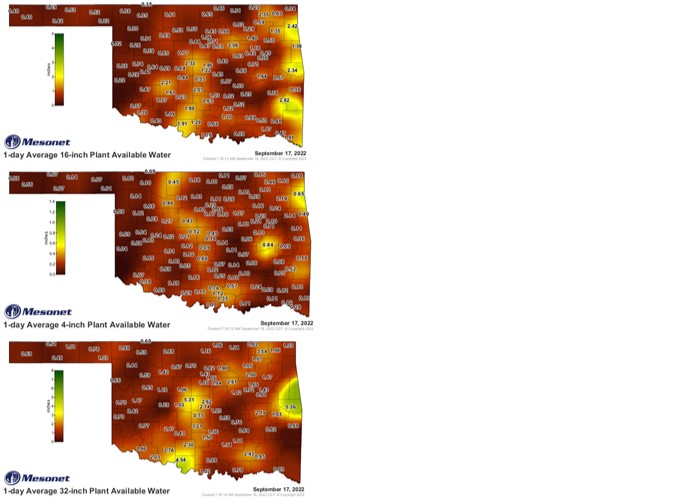Mon, 19 Sep 2022 09:40:02 CDT

Weekly, Dr. Derrell Peel, Oklahoma State University Extension Livestock Marketing Specialist, offers his economic analysis of the beef cattle industry. This analysis is a part of the weekly series known as the "Cow Calf Corner" published electronically by Derrell Peel, Mark Johnson and Paul Beck. Today, Dr. Peel talks about winter stocker prospects in the midst of drought.
Most years, September would be occupied by lots of attention to wheat planting and budgets for winter grazing of stockers. However, the latest Drought Monitor shows that 99.97 percent of Oklahoma is abnormally dry or worse (D0-D4) with 48.81 percent in D3 and D4 (Extreme or Exceptional Drought). The three maps below from the Mesonet system show plant available water at 4-inch, 16-inch and 32-inch depths. The dark red and brown colors of the maps indicate that the soil profile of much of the state is very dry from top to bottom.
The USDA Crop Progress report for September 13 showed that 11 percent of Oklahoma wheat was planted, ahead of the five-year average of four percent for that date. I traveled across much of western Oklahoma last week and did see several planted fields and even a couple with wheat emerged. In many cases the wheat is being “dusted in”, planted in dry soil, hoping that rain will be forthcoming to germinate the wheat. Whether wheat is planted with enough moisture to germinate or is waiting for rain to emerge, the dry soil profile means that additional timely rains will be needed to sustain a wheat stand. The forecast for the next week or more is for unseasonably (maybe record!) warm temperatures with little chance of precipitation. Wheat grazing prospects look dim and risky this fall.
The widespread drought conditions mean that I have received far less than the usual number of questions about the economic prospects for winter stockers this year. Nevertheless, there may be some grazing opportunities in some places. Stocker budgets are driven by the overall level of cattle prices and the relationship between purchase prices for lightweight stockers and the expected price of heavy feeder cattle later. The difference in the purchase price and selling price of stocker cattle is the rollback that determines the gross value of gain for adding weight to feeder cattle. The stocker price rollback is the mirror image of the cost of gain for feedlots because feeder markets reflect whether it is cheaper to put weight on feeder cattle in forage-based stocker programs before they arrive at the feedlot or with grain-based rations after placement in the feedlot. Southern plains feedlot cost of gain for steers is roughly $1.25 – $1.30/lb. currently, so stocker value of gain will typically be about that same level. For example, using current Oklahoma feeder prices, the value of 300 pounds of gain on a 475-pound steer is $1.29/lb. Moreover, for stockers that will be marketed after winter grazing, there is currently about a $7.00/cwt. increase in Feeder Futures prices between the nearby and March contracts which adds even more to the value of gain. In other words, if winter stocker grazing is possible, the budgets look attractive at this time.


















